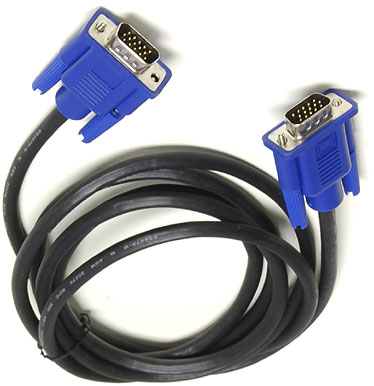VGA Cable | VGA Cable Full Form
A VGA cable (Video Graphics Array) is a type of cable commonly used to transmit video signals from a computer or other device to a display such as a monitor or a projector. It is one of the most widely used video cables and has been a standard for many years.
The VGA cable is a type of analog video cable that carries three separate signals - red, green, and blue - along with two additional signals for horizontal and vertical synchronization. This allows for the creation of high-quality images with vivid colors and crisp details.
How Does a VGA Cable Work?
The VGA cable works by transmitting analog signals from a video output source, such as a computer, to a display device, such as a monitor or a projector. The cable has a male connector on each end, with 15 pins arranged in three rows of five. One end of the cable is plugged into the video output port on the computer, and the other end is plugged into the VGA input port on the display device.
Once the cable is connected, the computer sends the video signals through the VGA cable to the display device. The display device then uses these signals to create an image on the screen.
Advantages of a VGA Cable
Compatibility:
VGA cables are compatible with a wide range of devices, including older computers, monitors, and projectors.
Cost-effective:
VGA cables are relatively inexpensive compared to other types of video cables.
High-quality images:
VGA cables can deliver high-quality images with vibrant colors and sharp details.
No digital conversion:
Since VGA cables transmit analog signals, there is no need for digital conversion, which can sometimes result in signal loss or degradation.
Disadvantages of a VGA Cable
Limited resolution:
VGA cables have a limited resolution and are not capable of transmitting high-definition (HD) video signals.
Signal degradation:
Over longer distances, VGA signals can suffer from signal degradation, which can result in a loss of image quality.
Limited distance:
VGA cables have a limited transmission distance, typically up to 30 meters, beyond which signal degradation can occur.
Bulky connectors:
VGA connectors are relatively large and bulky compared to other types of video cables.
Summary
VGA cables have been a popular choice for transmitting analog video signals for many years, and they continue to be widely used today. While they have some limitations, such as a limited resolution and transmission distance, they offer several advantages, such as compatibility with a wide range of devices, high-quality images, and low cost. If you need to connect a computer to a monitor or projector, a VGA cable may be a good choice. However, if you require high-definition video or longer transmission distances, other types of video cables may be more suitable.
FAQ
What is a VGA cable used for?
A VGA (Video Graphics Array) cable is used to transmit video signals from a computer or other VGA-compatible device to a monitor or display. VGA cables are analog and typically have a 15-pin connector on each end.
Is VGA better than HDMI?
In terms of image quality, HDMI (High-Definition Multimedia Interface) is generally considered to be better than VGA. HDMI can transmit higher resolution images and is capable of transmitting both audio and video signals. VGA, on the other hand, can only transmit video signals and is limited to lower resolutions.
What is the full form of VGA?
The full form of VGA is Video Graphics Array.
What is VGA to HDMI?
VGA to HDMI is a type of cable adapter that allows a device with a VGA output to be connected to a device with an HDMI input. This can be useful for connecting older computers or laptops to newer displays that only have HDMI inputs. The adapter converts the VGA analog signal to a digital HDMI signal, allowing the video to be displayed on the HDMI monitor or display.








Post a Comment